I plot a curve with JFreechart. Then the user can draw ranges by dragging the mouse. These I plot using AbstractChartAnnotation to draw a filled Path2D. So far so nice - all aligns perfectly with the curve.
When an area was already annotated the new annotation gets deleted. I use XYPlot.removeAnnotation with the new annotation.
My problem is that sometimes not only the "new" annotation gets removed, but also a second annotation elsewhere in the plot. It doesn't seem random - I kinda found annotations to the "right" side more prone to this happening.
I'm very confused what could cause this. The object that draws/deletes the new annotation is reinstated every time and only holds the current annotation - so how could the other annotation be deleted?
Would be very grateful for any hints, thanks.
As suggested I prepare a sscce example. Unfortunately it's not too short.
import java.awt.*;
import java.awt.event.MouseEvent;
import java.awt.geom.AffineTransform;
import java.awt.geom.Line2D;
import java.awt.geom.Point2D;
import java.awt.geom.Rectangle2D;
import java.util.*;
import java.util.List;
import javax.swing.JFrame;
import javax.swing.event.MouseInputListener;
import org.jfree.chart.ChartFactory;
import org.jfree.chart.ChartPanel;
import org.jfree.chart.JFreeChart;
import org.jfree.chart.annotations.AbstractXYAnnotation;
import org.jfree.chart.axis.ValueAxis;
import org.jfree.chart.plot.Plot;
import org.jfree.chart.plot.PlotOrientation;
import org.jfree.chart.plot.PlotRenderingInfo;
import org.jfree.chart.plot.XYPlot;
import org.jfree.data.time.Millisecond;
import org.jfree.data.time.TimeSeries;
import org.jfree.data.time.TimeSeriesCollection;
import org.jfree.data.time.TimeSeriesDataItem;
import org.jfree.ui.RectangleEdge;
/**
*
* @author c.ager
*/
public class IntegrationSSCE {
/**
* @param args the command line arguments
*/
public static void main(String[] args) {
JFrame jFrame = new JFrame();
jFrame.setLayout(new BorderLayout());
jFrame.setSize(600, 400);
jFrame.setDefaultCloseOperation(jFrame.EXIT_ON_CLOSE);
TimeSeriesCollection timeSeriesCollection = new TimeSeriesCollection();
TimeSeries timeSeries = new TimeSeries("test");
for (long i = 0; i < 1000; i++) {
double val = Math.random() + 3 * Math.exp(-Math.pow(i - 300, 2) / 1000);
timeSeries.add(new Millisecond(new Date(i)), val);
}
timeSeriesCollection.addSeries(timeSeries);
JFreeChart chart = ChartFactory.createTimeSeriesChart(
null,
null, "data", timeSeriesCollection,
true, true, false);
ChartPanel chartPanel = new ChartPanel(chart);
chartPanel.removeMouseListener(chartPanel);
Set<MyAnnot> annotSet = new TreeSet<MyAnnot>();
AnnotListener list = new AnnotListener(chartPanel, annotSet, timeSeries);
chartPanel.addMouseListener(list);
chartPanel.addMouseMotionListener(list);
jFrame.add(chartPanel, BorderLayout.CENTER);
jFrame.setVisible(true);
// TODO code application logic here
}
private static class AnnotListener implements MouseInputListener {
Point2D start, end;
MyAnnot currAnnot;
final Set<MyAnnot> annotSet;
final ChartPanel myChart;
final TimeSeries timeSeries;
public AnnotListener(ChartPanel myChart, Set<MyAnnot> annotSet, TimeSeries timeSeries) {
this.myChart = myChart;
this.annotSet = annotSet;
this.timeSeries = timeSeries;
}
@Override
public void mousePressed(MouseEvent e) {
start = convertScreePoint2DataPoint(e.getPoint());
currAnnot = new MyAnnot(start, timeSeries, myChart.getChart().getXYPlot());
myChart.getChart().getXYPlot().addAnnotation(currAnnot);
}
@Override
public void mouseDragged(MouseEvent e) {
end = convertScreePoint2DataPoint(e.getPoint());
currAnnot.updateEnd(end);
}
@Override
public void mouseReleased(MouseEvent e) {
boolean test = annotSet.add(currAnnot);
if (!test) {
myChart.getChart().getXYPlot().removeAnnotation(currAnnot);
}
}
@Override
public void mouseEntered(MouseEvent e) {
}
@Override
public void mouseClicked(MouseEvent e) {
}
@Override
public void mouseExited(MouseEvent e) {
}
@Override
public void mouseMoved(MouseEvent e) {
}
protected Point2D convertScreePoint2DataPoint(Point in) {
Rectangle2D plotArea = myChart.getScreenDataArea();
XYPlot plot = (XYPlot) myChart.getChart().getPlot();
double x = plot.getDomainAxis().java2DToValue(in.getX(), plotArea, plot.getDomainAxisEdge());
double y = plot.getRangeAxis().java2DToValue(in.getY(), plotArea, plot.getRangeAxisEdge());
return new Point2D.Double(x, y);
}
}
private static class MyAnnot extends AbstractXYAnnotation implements Comparable<MyAnnot> {
Long max;
Line2D line;
final TimeSeries timeSeries;
final XYPlot plot;
final Stroke stroke = new BasicStroke(1.5f);
public MyAnnot(Point2D start, TimeSeries timeSeries, XYPlot plot) {
this.plot = plot;
this.timeSeries = timeSeries;
line = new Line2D.Double(start, start);
findMax();
}
public void updateEnd(Point2D end) {
line.setLine(line.getP1(), end);
findMax();
fireAnnotationChanged();
}
@Override
public void draw(Graphics2D gd, XYPlot xyplot, Rectangle2D rd, ValueAxis va, ValueAxis va1, int i, PlotRenderingInfo pri) {
PlotOrientation orientation = plot.getOrientation();
RectangleEdge domainEdge = Plot.resolveDomainAxisLocation(
plot.getDomainAxisLocation(), orientation);
RectangleEdge rangeEdge = Plot.resolveRangeAxisLocation(
plot.getRangeAxisLocation(), orientation);
double m02 = va.valueToJava2D(0, rd, domainEdge);
// y-axis translation
double m12 = va1.valueToJava2D(0, rd, rangeEdge);
// x-axis scale
double m00 = va.valueToJava2D(1, rd, domainEdge) - m02;
// y-axis scale
double m11 = va1.valueToJava2D(1, rd, rangeEdge) - m12;
Shape s = null;
if (orientation == PlotOrientation.HORIZONTAL) {
AffineTransform t1 = new AffineTransform(
0.0f, 1.0f, 1.0f, 0.0f, 0.0f, 0.0f);
AffineTransform t2 = new AffineTransform(
m11, 0.0f, 0.0f, m00, m12, m02);
s = t1.createTransformedShape(line);
s = t2.createTransformedShape(s);
} else if (orientation == PlotOrientation.VERTICAL) {
AffineTransform t = new AffineTransform(m00, 0, 0, m11, m02, m12);
s = t.createTransformedShape(line);
}
gd.setStroke(stroke);
gd.setPaint(Color.BLUE);
gd.draw(s);
addEntity(pri, s.getBounds2D(), i, getToolTipText(), getURL());
}
@Override
public int compareTo(MyAnnot o) {
return max.compareTo(o.max);
}
private void findMax() {
max = (long) line.getP1().getX();
Point2D left, right;
if (line.getP1().getX() < line.getP2().getX()) {
left = line.getP1();
right = line.getP2();
} else {
left = line.getP2();
right = line.getP1();
}
Double maxVal = left.getY();
List<TimeSeriesDataItem> items = timeSeries.getItems();
for (Iterator<TimeSeriesDataItem> it = items.iterator(); it.hasNext();) {
TimeSeriesDataItem dataItem = it.next();
if (dataItem.getPeriod().getFirstMillisecond() < left.getX()) {
continue;
}
if (dataItem.getPeriod().getFirstMillisecond() > right.getX()) {
break;
}
double curVal = dataItem.getValue().doubleValue();
if (curVal > maxVal) {
maxVal = curVal;
max = dataItem.getPeriod().getFirstMillisecond();
}
}
}
}
}
Here is the problematic behaviour. Note that images 2 and 4 were taken while the mouse button was pressed.
- select a few non-overlapping lines - no problem as it should be





I have just been looking at it in the debugger - could it be that ArrayList.remove(Object o) removes the WRONG element? Seems very unlikely to me...